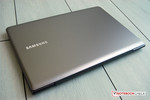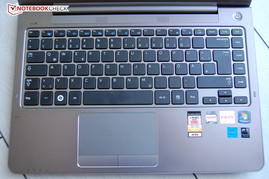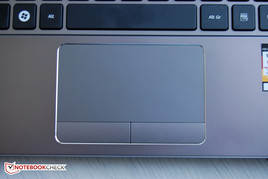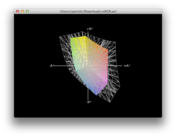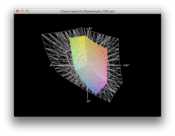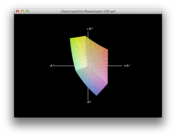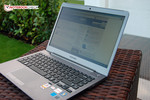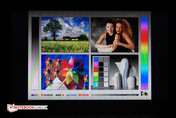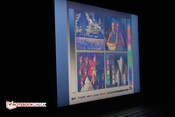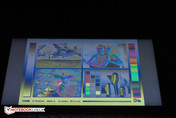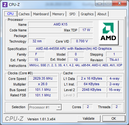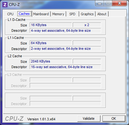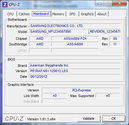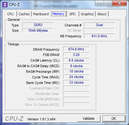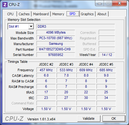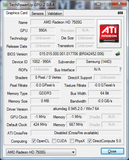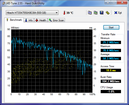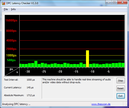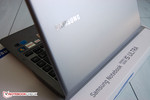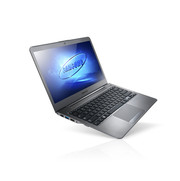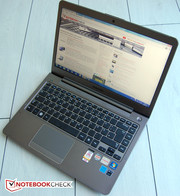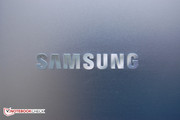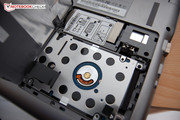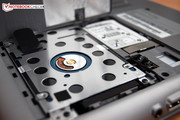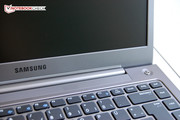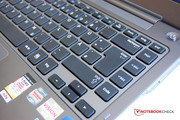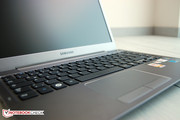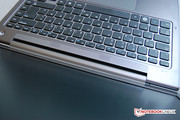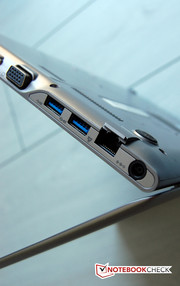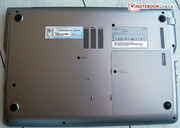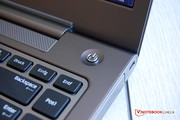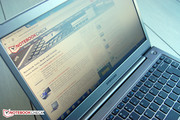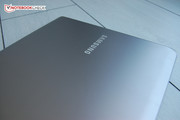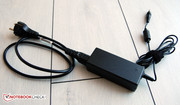Review Samsung Series 5 535U4C Notebook
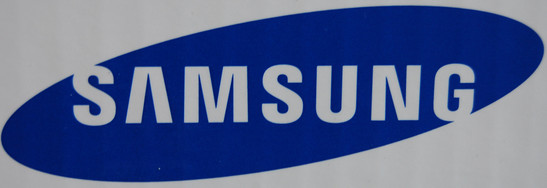
Time to break new ground. That's what Samsung's engineers must have decided when they collaborated on the technical specs of the newest member of the Series 5. Until now, all variants of the series incorporated processors from Intel - and, if available, dedicated GPUs from Nvidia. The Series 5 535U4C, on the other hand, is powered by AMD. At the core of the compact 14-inch system is the AMD A6-4455 with the AMD Radeon HD 7500G for integrated graphics. Should additional performance be required, the notebook can utilize the dedicated (middle-tier) AMD Radeon HD 7550M which supports DX11. Unlike AMD's Crossfire technology, the two cards don't work in parallel. Depending on the demands, either one or the other cards is supposed to tackle the workload: the integrated card being used for simple tasks (and conserves power) while the dedicated card comes into play when 3D power is required. AMD recently started calling their automatic graphics-switching technology "Enduro", behaving very similar to Nvidia's "Optimus" which has been on the market for a while and works quite reliably.
Even though the 535U4C is not an Ultrabook, Samsung pretty much adheres to Intel's guidelines. The CPU is a dual-core Ultra-Low-Voltage model with a clock speed of 2.1 to 2.6 GHz and has a TDP of 17 watts. Other essential specifications include 8 GB RAM, an optical drive, non-glare display, and fairly low weight of 1.84 kilograms (4.06 pounds).
In addition to our test model with the AMD CPU, Samsung offers another 14-inch in the same series (530U4C) with an Intel Core i7-3517UM and 8 GB of RAM. The MSRP of the notebook is 999 Euro (~$1250).
Case
The chassis of the Series 5 535U4C is very similar in style to the previously reviewed Samsung 530U3B-A01DE. For more information, please take a look at this review. Differences compared to the 13.3-inch model are due to the slightly larger dimensions. The 535U4C is about 440 grams (0.97 pounds) heavier and now weighs in at 1840 grams (4.06 pounds) - still a comparatively low weight for a 14-inch notebook. The dimensions are 20 x 333 x 229.5 millimeter (0.79 x 13.11 x 9.04 inches). While the 535U4C is not an ultra-thin notebook, it is very compact, especially considering that Samsung included an optical drive.
As far as the materials and the construction are concerned, we don't have any complaints. In that aspect, the 14-inch model is just like its sibling. Build quality and appearance of the aluminum and fiberglass notebook are top-notch. Unfortunately, Samsung did not improve the overall stiffness of the chassis. Hence both the display and the base unit of the 14-inch model lack torsional rigidity. In addition, the area above the keyboard is fairly soft and "gives" when pressure is applied.
We also thought that the single display hinge could be improved. Despite the fact that it is 23 cm (9.06 inches) long, it doesn't do a very good job holding the display in place. Even light touches cause the display to wobble for several seconds. In addition, the display can't be tilted backwards more than 135 degrees.
Connectivity
The type, number, and position of the ports are almost identical to the 13.3-inch model. The most significant change is the inclusion of an optical drive on the right hand side towards the back. In addition, the VGA port is now full-sized. The smaller models in the series required an adapter cable to use the analog display port - and that cable was not included with the most recent generation. The LAN port has a hinged drop-down element so the port is only open when an RJ45 cable is plugged in. This detail leads to lower overall height of the port. The location of the ports is quite user friendly, save for USB 2.0 port on the right side of the chassis. This port (which frequently will be used to plug in an external mouse) is at the height of the palm rest and has the potential to clutter the desk a little. There are no ports at the back and front of the notebook. HDMI, headphone jack, and Kensington lock slot complete the generous port selection.
Communication
Here we encounter a component change from the smaller to the bigger models. The reason: the AMD architecture. While the 13.3-inch model comes equipped with an Intel Centrino chip (and adheres to the Ultrabook standard), the 14-inch 535U4C uses a WLAN controller from Qualcomm. The Atheros AR5BWB222 Wireless Network Adapter supports WLAN 802.11n, just like the Centrino chip. The physical network adapter remains unchanged (Gigabit controller from Realtek).
Accessories
Not much to report here. Aside from a recovery DVD, a quickstart guide, and warranty information, nothing else is included in the rather compact cardboard box. Samsung does supply some "free" software with the 535U4C. Most of said software is not very beneficial, since either the functionality is reduced or the software limited to a trial period (Norton Internet Security, Microsoft Office 2010). The Samsung-specific tools included to restore or backup the system are more useful.
Maintenance
As far as ease of maintenance is concerned, the new notebook takes a step backwards. The 13.3-inch models had a cover that allowed access to the hard drive, RAM, and the fan - the new 535U4C has a cover that hides just the hard drive and the RAM. All other components are only accessible if the whole bottom cover is taken off. Since we were supplied a preview sample, we decided to not do that.
Warranty
Samsung offers a warranty of 24 months. This "flexible service" can be extended to 36 or 48 months. Should the user decide to extend the warranty, he or she has to do so within the first 90 days after the purchase. Samsung did not provide a price for the extensions.
Input Devices
Keyboard
The slightly larger size of the 14-inch Series 5 535U4C compared to the 13.3-inch 530U3B-A01DE does benefit the keyboard design. The regular keys are still the same size (15 millimeter / 0.59 inches), but the Enter key now has a larger surface area. In addition, the right side now has room for frequently used keys like PgUP, PgDn, Home, and End. Overall, this is not a bad idea, although the placement causes (at least initially) some issues for touch typists, as they tend to expect the Enter, Shift, or Backspace keys on the right perimeter. After a longer adjustment period, we were able to type without any issues. The key travel is ample and tactile feedback very good. Just like on the smaller model, the keyboard is not backlit.
Touchpad
Samsung decided to incorporate the same - and very good - touchpad found in the smaller models. The size of the touchpad is more than adequate and cursor operation speedy and smooth. The latter feature makes multi-touch gestures quite easy to use. The large mouse buttons function well but emit rather loud clicking sounds in different pitch levels.
Display
Smaller and less expensive notebooks often suffer from highly reflective displays. The Series 5 535U4C is (like most Samsung models) a laudable exception here. Samsung uses their non-glare TN panel, also found in the 13.3-inch notebook. Even though the screen real estate is slightly larger, Samsung left the resolution untouched. The display features 1366 x 768 pixels - a little behind times, especially considering that a manufacturer like Asus already include FullHD displays even in their smaller models.
No other displays are offered, which is not surprising in this price bracket. Our test measurements leave us torn: one one hand, the display has very good brightness levels, which allow the notebook to be used even in very bright conditions. We measured a maximum brightness of 360 cd/m2 and about 330 cd/m2 average. On the other hand, the contrast is not much better than what entry-level systems typically offer. Although certainly acceptable during daily use, the contrast and the black level negatively impact viewing angles.
| |||||||||||||||||||||||||
Brightness Distribution: 78 %
Center on Battery: 334 cd/m²
Contrast: 151:1 (Black: 2.21 cd/m²)
38.43% AdobeRGB 1998 (Argyll 3D)
55.7% sRGB (Argyll 3D)
37.16% Display P3 (Argyll 3D)
| |||||||||||||||||||||||||
Brightness Distribution: 87 %
Center on Battery: 337 cd/m²
Contrast: 139:1 (Black: 2.43 cd/m²)
38.43% AdobeRGB 1998 (Argyll 3D)
55.7% sRGB (Argyll 3D)
37.16% Display P3 (Argyll 3D)
Color reproduction of the Samsung Serie 5 535U4C seems OK - at least when you look at the display subjectively. We didn't notice any color casts and the individual colors are fairly vivid. The comparison below shows that the display is miles away from a true color reproduction: the panel only covers about 57 percent of the sRGB color space. Of course the Series 5 535U4C was not developed for professional graphics artists - but we do think that such a restricted color space limits even the home photographer.
As far as using the notebook outside is concerned, we have absolutely no reasons to complain. Matte display and high brightness are exactly what are needed to combat the glare of the sun. The display remains readable unless exposed to the sun directly. This means that the 535U4C is well suited for outdoor use. Thumbs up!
While the Samsung garners bonus points for outdoor usability, it loses them when we take a look at the viewing angle stability. We usually don't expect much in terms of viewing angles from TN displays. But because of the low contrast, TN-typical effects occur very quickly on this notebook when deviating of the center line. Especially vertical viewing angles are very restricted and colors invert early. Since the display also doesn't tilt back very far, we frequently found ourselves trying to find the perfect angle when we worked with the notebook on our lap.
Performance
With the nod towards the AMD Trinity platform, Samsung incorporates a slightly less powerful architecture than the Intel architecture used in the smaller 13.3-inch models. Since the 535U4C doesn't have Intel components, it can't be called an Ultrabook anymore either. The AMD A6-4455M has clock speeds of 2.1/2.6 GHz, and utilizes two Piledriver cores. Although the CPU is definitely not a speed demon, the notebook should work out well as a mobile companion - as long as the tasks are not too CPU intensive. The 8 GB DDR3 SDRAM are also more than adequate.
More interesting than the CPU is the integrated graphics card AMD Radeon HD 7500G which is present with the discrete AMD Radeon HD 7550M. This middle-tier GPU promises plenty of 3D muscle.
Processor
We already talked about the CPU - what's missing is a discussion of its performance. We use the well-known tools Cinebench R10 und R11.5 and other benchmark tests to determine CPU performance. Examples are the single-thread test SuperPi, the multi-thread test wPrime, and the tests WinRAR and TrueCrypt (which simulate "real" conditions encountered during daily use). The AMD A6-4455M supports overclocking under load and when temperature permits. The frequency range is between 2.1 and 2.6 GHz. During our tests, the technology (called Turbo Core 3.0) worked without issues.
Both Cinebench programs confirm the suspicion that the AMD A6-4455M is no performance powerhouse. During rendering with one core (Cinebench R10 32bit), the Series 5 535U4C only managed to reach 1943 points. This is about half of what the Apple MacBook Air (with Intel Core i5-3427U) is capable of - and its CPU is also dual-core and features the same TDP of 17 watts. The performance of the Intel processor also scales better when both cores are used. The multi-thread rendering test shows a factor of 2.1 for Intel, whereas the AMD CPU in the Samsung only manages a factor of 1.34 when both Piledriver cores are working. This increase is exactly the same as the step from Cinebench R10 32bit to 64bit. The reason for the unimpressive scaling would be the Trinity architecture. Technically, the cores are not separate. Rather, the CPU is comprised of two integer cores sharing a FPU unit and the cache.
The prime number tests wPrime and SuperPI also confirm the lackluster performance of the AMD CPU. The A6-4455M in the Samsung 535U4 scores about the same as the AMD A6-3400M - which sports a core frequency of only 1.4 GHz and dates back to the Llano-era. In the multi-thread test wPrime, the Trinity CPU scores even lower and performs roughly like the AMD E-450.
System Performance
What is true for the processor, can also be said about the system performance: it's not exactly overwhelming. To evaluate the performance, we use PCMark 7 and PCMark Vantage. Unfortunately, PC Mark 7 always got stuck in an endless loop in the section "Video Playback" - so we don't have any results here. The 3947 points our test system scored in the PCMark Vantage test puts its performance between the Sony Vaio VPC-EH3C0E/W (Intel Pentium B960; Intel HD Graphics) and the Toshiba Satellite L755D-14U (AMD A6-3420M; AMD Radeon HD 6520G + HD 7450M Dual Graphics). Both of those models are based on the respective previous generation architecture: the Sony has a Sandy Bridge and the Toshiba a Llano based processor.
Overall system performance is unimpressive. The culprit could be the choice of hardware components on one, and the driver model and controller architectures on the other side. A slow hard drive is also frequently one of the main bottlenecks.
| PCMark Vantage Result | 3947 points | |
Help | ||
Storage Devices
Samsung uses a conventional hard drive in the Series 5 535U4C. The Travelstar 5K750 from Hitachi has a capacity of 500 GB and spins at 5400 RPM. The specifications indicate that the hard disk drive subsystem won't be especially fast. In addition, the hard drive of the 14-inch system is not able to reach its full potential. According to our hard drive benchmark list, the performance of the Hitachi drive should be quite a bit better than what we measured. HDTune recorded an average data transfer rate of 58.3 MB/s, which is quite slow. The average we recorded for other notebooks with this particular drive is about 75 MB/s. CrystalDiskMark confirms the result: 66 MB/s for the sequential read is not very fast. During sequential writes, the speed drops to less than 40 MB/s. Our benchmark table indicates that the hard drive is capable of double the performance. This seems to indicate that the Series 5 535U4C has some issues with the controller architecture. These issues cause the hard drive to decrease the overall performance of the notebook.
Graphics Card
The graphics subsystem of the 535U4C warrants a closer look. The Korean manufacturer sources both the processor and the graphics cards used in the 535U4C from AMD. The Trinity APU has an integrated AMD Radeon HD 7500G - a lower middle-tier card which supports DirectX 11. Based on our experience, the integrated graphics solution of the Trinity processors outperforms the competitor, Intel's HD Graphics 4000. At least as far as the intended use-case scenario is concerned, the Samsung notebook should offer reasonable graphics performance, even if the CPU itself is lacking. Samsung obviously disagrees and adds a dedicated middle class AMD Radeon HD 7550M, which is based on the same graphics chip as the Radeon HD 6630M, but is less powerful - in fact, the 7550M offers even less 3D performance than a Radeon HD 6530M. Current games should probably be played on medium detail to avoid any lags.
The internal graphics card is more power efficient and handles simple 2D tasks. The dedicated graphic card is supposed to take over when demands increase (like with the case of 3D). According to AMD's website, this switching - called AMD Enduro - is supposedly automatic. In the case of our test system, it's a semi-automatic process: after exiting a program, a window opens and the user is asked to select the desired graphics option (either energy saving / internal or high performance / dedicated graphics card). During the review period, this process worked reliably - having to switch manually is a bit of a nuisance however. In addition, the pop-up window does not show the previous selection, even though the information is not lost. The user has to search for the .exe to determine what the system is using.
We conducted the graphics benchmark tests using the dedicated graphics card, since we wanted to find out what kind of 3D performance the system is capable of. Our test system scored 2552 points running 3DMark Vantage. This puts the performance of the 535U4C on the same level as notebooks equipped with an AMD Radeon HD 6490M or an Nvidia GeForce 610M - both cards that are just a little above entry level graphics. The Samsung fares a bit better running 3DMark 06: 4804 points. This performance is about what one would expect from laptops equipped with a Radeon HD 7450M - a card ranked below the Radeon HD 7550M. Overall, the synthetic 3D performance is definitely lacking. While we don't know what the exact cause is, we suspect the driver model and maybe the Enduro-mechanism from AMD. We can only hope that Samsung and AMD will remedy this shortcoming.
| 3DMark 2001SE Standard | 16206 points | |
| 3DMark 03 Standard | 14252 points | |
| 3DMark 05 Standard | 8746 points | |
| 3DMark 06 Standard Score | 4804 points | |
| 3DMark Vantage P Result | 2472 points | |
| 3DMark 11 Performance | 780 points | |
Help | ||
Gaming Performance
After the disappointing performance during the 3DMark tests, we didn't expect too much as far as the gaming performance of the Samsung Series 5 535U4C is concerned. To get an idea how the dedicated card compares to the integrated graphics, we ran our benchmarks for each GPU. Our database only lists the performance of the (more powerful) dedicated graphics card.
In every test, the AMD Radeon HD 7550M was superior to the integrated HD 7500G. The difference in performance was quite significant at times. Running Batman: Arkham City using the HD 7550M, we recorded 41 fps using low and 34 fps using medium details - frame rates high enough for decent performance without any stuttering. For the 7500G, we measured 32 and 26 fps, respectively - already a bit too low. Anno 2070 had the dedicated card pull ahead even further. Details should be set to low for both graphic options. We also recommend the lowest settings for F1 2011. Call of Duty: Black Ops, on the other hand, runs OK with the 7550M set to medium details; the internal graphics card is operating near its limit here at 22 fps.
We then compared the results of various other notebooks playing Anno 2070 to our test system and were able to confirm what we saw during the 3DMark tests: the uninspiring performance of the 535U4C translates directly to sub-par gaming performance. Systems with a (theoretically weaker) GeForce 610M bested the Samsung by a fair margin. Even Intel HD Graphics 4000 is able to keep up with the dedicated AMD Radeon HD 7550M in this 14-inch notebook. The results are simply very disappointing. The dedicated graphics card isn't beneficial here, especially considering that it increases the system price and is more power hungry to boot.
| Anno 2070 | |
| 1024x768 Low Preset (sort by value) | |
| Samsung 535U4C | |
| Fujitsu LifeBook U772 | |
| Lenovo IdeaPad U410-MAH6MGE | |
| 1366x768 Medium Preset AA:on (sort by value) | |
| Samsung 535U4C | |
| Fujitsu LifeBook U772 | |
| HP ProBook 4740s (B6N57EA) | |
| Lenovo IdeaPad U410-MAH6MGE | |
| 1366x768 High Preset AA:on AF:2x (sort by value) | |
| Samsung 535U4C | |
| Fujitsu LifeBook U772 | |
| HP ProBook 4740s (B6N57EA) | |
| Lenovo IdeaPad U410-MAH6MGE | |
| low | med. | high | ultra | |
|---|---|---|---|---|
| Call of Duty: Black Ops (2010) | 37 | 29 | 25 | |
| F1 2011 (2011) | 25 | 18 | 12 | |
| Batman: Arkham City (2011) | 41 | 34 | 12 | |
| The Elder Scrolls V: Skyrim (2011) | 29 | 21 | 14 | |
| Anno 2070 (2011) | 36 | 14 | 9 |
System Noise
The F11 function key is home to a little blue fan symbol. The second function of the key activates the Silent Mode, which immediately decreases rpm and consequently the system noise level. Even without said mode, the Samsung Series 5 535U4C is certainly not very noisy. During idle, the system is only audible when the surrounding area is extremely quiet. With Silent Mode active, we measured between 31.6 and 33.5 dB, and with it switched off, the noise level increases by about 2 dB. Even under load, the 14-inch system is comparatively quiet. We measured a maximum of 37.4 dB. While the system is certainly not quiet any longer, we should consider that other systems emit a lot more noise when the fan is spinning at maximum rpm.
Noise level
| Idle |
| 31.6 / 32.1 / 33.5 dB(A) |
| HDD |
| 32 dB(A) |
| DVD |
| 34.2 / dB(A) |
| Load |
| 37.4 / 37.4 dB(A) |
 | ||
30 dB silent 40 dB(A) audible 50 dB(A) loud |
||
min: | ||
Temperature
The AMD Ultra-Low-Voltage Trinity-APU is also used in much smaller notebooks. Consequently, the cooling system of the Samsung Series 5 535U4C should have no issues dealing with the thermal output of the APU. As expected, the temperatures we encountered were no reason for concern. During normal use, when both the processor and the graphics card are mostly at idle, the temperature on the top never increased above 38 degrees Celsius (100.4 degrees Fahrenheit).The warmest spot is near the power jack. At the bottom in that location we measured 40 degrees Celsius (104 degrees Fahrenheit) - perfectly OK still to have the notebook sitting on the lap. We also noticed that the palm rest is very cool on the right side but heats up a bit towards the middle and especially the left side. A temperature of 34 degrees Celsius (93.2 degrees Fahrenheit) is still quite acceptable.
Under full load (during the stress test with FurMark and Prime95), the temperature of the base unit increases by quite a bit. The hot spot is again the area near the power jack. A temperature of 50 degrees Celsius (122 degrees Fahrenheit) is a little too hot for our taste. The palm rest, however, is barely warmer than during idle.
Processor and graphics card get a lot warmer. During the stress test the AMD A6-4455M reaches temperatures of 89.5 degrees Celsius (193.1 degrees Fahrenheit). The result is throttling to below the base frequency of 2.1 GHz to 1.5 GHz. The processor bounces back quickly though, and overclocks to 2.7 GHz (HWiNFO64). The integrated AMD Radeon HD 7550M heats up to 81 degrees Celsius (177.8 degrees Fahrenheit) and throttles back accordingly. The frequency range adjusts from 150 to 900 MHz. This temporary throttling does not decrease the overall performance of the Series 5 535U4C. We could not discern any difference while playing games or running the 3DMark06 benchmark test while the laptop was hot.
(-) The maximum temperature on the upper side is 50 °C / 122 F, compared to the average of 36.9 °C / 98 F, ranging from 21.1 to 71 °C for the class Multimedia.
(-) The bottom heats up to a maximum of 50.1 °C / 122 F, compared to the average of 39.2 °C / 103 F
(±) In idle usage, the average temperature for the upper side is 34.1 °C / 93 F, compared to the device average of 31.3 °C / 88 F.
(+) The palmrests and touchpad are reaching skin temperature as a maximum (35.7 °C / 96.3 F) and are therefore not hot.
(-) The average temperature of the palmrest area of similar devices was 28.7 °C / 83.7 F (-7 °C / -12.6 F).
Speakers
The speakers of the Samsung Series 5 535U4C are located between the display and the keyboard and cover about three fourths of the width of the notebook. Even though the speakers seem large enough, the bass is lacking and not very powerful. Maximum volume could be higher, too. The mids and highs of the 14-inch laptop are sufficiently loud and clear though. The overall sound is certainly decent enough for movies and YouTube videos. The headphone jack works flawlessly - so we recommend hooking up external speakers or using headphones to listen to music.
Power Consumption
Despite the fact that the system features a dedicated graphics card and a larger display, Samsung decided to use the same battery that the 13.3-inch model ships with. The lithium polymer battery has a capacity of 45 Wh and is not replaceable by the user. Looking at the result of our tests, we understand why Samsung decided to not switch to a larger battery (even though it would have been beneficial). Compared to the 13.3-inch Series 5 530U3C-A01DE, power consumption of our test system is up only slightly during idle. 7.8 to 12.5 watts are certainly not unreasonable. We expect about 10 watts during every-day use. During CPU and GPU intensive tasks, power consumption goes up of course - especially because of the dedicated graphics card. We measured a maximum value of 38.5 watts which is certainly quite acceptable. All in all, the Samsung Series 5 535U4C is quite energy efficient.
| Off / Standby | |
| Idle | |
| Load |
|
Key:
min: | |
Battery life
Even though the system isn't very power hungry, overall battery life is not particularly great since the battery is quite small. When we checked the maximum run time using the Battery Eater Reader's test, we got slightly more than eight hours. The minimum battery life (established with the Classic test) is quite decent at 01 hour 48 minutes. Since both of those measurements are not that useful to determine every-day performance, we ran our WLAN surfing test. With brightness set to 150 cd/m2, it took four and a half hours before the system shut down. This is not that impressive and we would have expected at least five hours for a notebook in this category.
The system is well suited for DVD playback. The Samsung Series 5 5354U4C lasted for well over three hours, which long enough even for two movies played back to back.
Verdict
For our final verdict, we look at all the positive aspects of the Series 5 535U4C and work our way to the flaws. Let's start with the case. Build quality is superb, and the materials used (aluminum and fiberglass) would look at home on much more expensive notebook. The 14-inch notebook is visually appealing and timeless. Unfortunately, the system is not quite as sturdy as we would like.
As far as the port selection is concerned, the Samsung comes well equipped. Even full-sized LAN and VGA ports are included. The inclusion of a DVD-RW drive makes the Series 5 535U4C a perfect all-round system. We also liked the keyboard and the touchpad - with very few reservations.
The new model scores well as far as mobility is concerned. The weight is pretty low for a 14-inch system and the battery life is OK. Since the display is both non-glare and bright, users can work outdoors away from any outlet for several hours. Although we appreciate the matte display and its impressive brightness, we do wish for better contrast and better viewing angle stability.
Another point of criticism is the sub-par power output. We knew we wouldn't get wowed by the performance of the Trinity CPU and the graphics card in the first place, but both the processor and the graphics system disappointed and performed below expectations. The hard drive is also sluggish and slows the system down further. The notebook is suitable for gaming as long as the games are set to low details. In theory, the AMD Radeon HD 7550M should be capable of much better performance. We suspect that the graphics switch-system Enduro and underdeveloped drivers are the culprit.
So what is the bottom line? We think that the negative aspects overwhelm the positive ones and are therefore hard pressed to recommend the Samsung Series 5 535U4C. Both the driver model and the integration of the two graphic cards could use some improvement. An interesting alternative is the Samsung 530U4C, which features an Intel ULV CPU, a GT 620M GPU, and the more usable Optimus graphics-switching technology from Nvidia. Unfortunately that system costs about 200 Euro (~$250) more.




